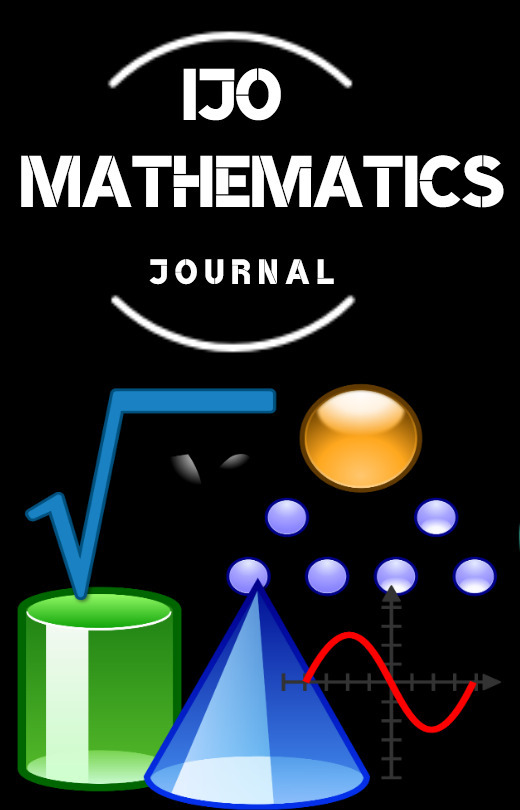A Mathematical Model on Cholera Outbreak with Vaccination
Abstract
This study develops and analyzes a cholera transmission model of SIRB type (Sus-
ceptible–Infected–Recovered–Bacteria) that incorporates vaccination. The main
objective is to investigate the threshold conditions under which cholera can either
be eradicated or persist in the community. The model formulation captures both
direct person-to-person transmission and indirect infection through contaminated
water. Using standard dynamical systems techniques, the disease-free equilibrium
(DFE) and endemic equilibrium (EE) were derived. The next-generation matrix
approach was then applied to obtain the basic reproduction number, R0, which
serves as the central threshold parameter governing disease dynamics. The analysis
showed that the DFE is locally asymptotically stable whenever R0 < 1, implying
cholera elimination under effective interventions, while the EE exists and is locally
stable when R0 > 1, confirming sustained disease persistence. These results em-
phasize the importance of vaccination and improvements in sanitation as essential
strategies to reduce R0 below unity and achieve long-term cholera control
References
cholera in endemic countries. PLoS Neglected Tropical Diseases, 9(6):e0003832.
Anderson, R. M. and May, R. M. (1991). Infectious Diseases of Humans: Dynamics and
Control. Oxford University Press.
Bertuzzo, E., Mari, L., Righetto, L., Gatto, M., Casagrandi, R., Blokesch, M., and
Rinaldo, A. (2011). Prediction of the spatial evolution and effects of control measures
for the unfolding haiti cholera outbreak. Geophysical Research Letters, 38(6).
Capasso, V. and Paveri-Fontana, S. L. (1979). A mathematical model for the 1973
cholera epidemic in the european mediterranean region. Revue d’ ´Epid´emiologie et de
Sant´e Publique, 27(2):121–132.
Castillo-Chavez, C. and Feng, Z. (1997). To treat or not to treat: The case of tuberculosis.
Journal of Mathematical Biology, 35(6):629–656.
Chao, D. L., Halloran, M. E., and Longini, I. M. (2011). Vaccination strategies for
epidemic cholera in haiti with implications for the developing world. Proceedings of the
National Academy of Sciences, 108(17):7081–7085.
Code¸co, C. T. (2001). Endemic and epidemic dynamics of cholera: The role of the aquatic
reservoir. BMC Infectious Diseases, 1:1.
Eisenberg, M. C., Shuai, Z., Tien, J. H., and Van den Driessche, P. (2013). A cholera
model in a patchy environment with water and human movement. Mathematical Bio-
sciences, 246(1):105–112.
Hartley, D. M., Morris, J. G., and Smith, D. L. (2006). Hyperinfectivity: A critical
element in the ability of vibrio cholerae to cause epidemics? PLoS Medicine, 3(1):e7.
Hethcote, H. W. (2000). The mathematics of infectious diseases. SIAM Review, 42(4):599–
653.
Koelle, K. and Pascual, M. (2004). Disentangling extrinsic from intrinsic factors in
disease dynamics: A nonlinear time series approach with an application to cholera.
The American Naturalist, 163(6):901–913.
Leung, D. T., Rahman, M. A., Mohasin, M., Riyadh, M. A., Patel, S. M., Aktar, A., and
Qadri, F. (2012). Comparison of immune responses to the killed oral cholera vaccine
between bangladeshi children and adults. Vaccine, 30(4):594–599.
Longini, I. M., Nizam, A., Ali, M., Yunus, M., Shenvi, N., and Clemens, J. D. (2007).
Controlling endemic cholera with oral vaccines. PLoS Medicine, 4(11):e336.
Mukandavire, Z., Liao, S., Wang, J., Gaff, H., Smith, D. L., and Morris, J. G. (2011).
Estimating the reproductive numbers for the 2008–2009 cholera outbreaks in zimbabwe.
Proceedings of the National Academy of Sciences, 108(21):8767–8772.
Pascual, M., Rod´o, X., Ellner, S. P., Colwell, R., and Bouma, M. J. (2000). Cholera
dynamics and el ni˜no–southern oscillation. Science, 289(5485):1766–1769.
Qadri, F., Wierzba, T. F., Ali, M., and Clemens, J. D. (2020). Cholera in yemen—an old
foe rearing its ugly head. New England Journal of Medicine, 382(6):568–571.
Tien, J. H. and Earn, D. J. D. (2010). Multiple transmission pathways and disease dy-
namics in a waterborne pathogen model. Bulletin of Mathematical Biology, 72(6):1506–
1533.
Troeger, C., Blacker, B. F., Khalil, I. A., Rao, P. C., Cao, J., Zimsen, S. R., and Reiner,
R. C. (2018). Estimates of the global, regional, and national morbidity, mortality, and
aetiologies of diarrhoea in 195 countries: A systematic analysis for the global burden
of disease study 2016. The Lancet Infectious Diseases, 18(11):1211–1228.
Van den Driessche, P. and Watmough, J. (2002). Reproduction numbers and sub-
threshold endemic equilibria for compartmental models of disease transmission. Math-
ematical Biosciences, 180(1–2):29–48.
World Health Organization (2023). Cholera. https://www.who.int/news-room/
fact-sheets/detail/cholera. Accessed: 2025-09-30.
Author(s) and co-author(s) jointly and severally represent and warrant that the Article is original with the author(s) and does not infringe any copyright or violate any other right of any third parties and that the Article has not been published elsewhere. Author(s) agree to the terms that the IJO Journal will have the full right to remove the published article on any misconduct found in the published article.

